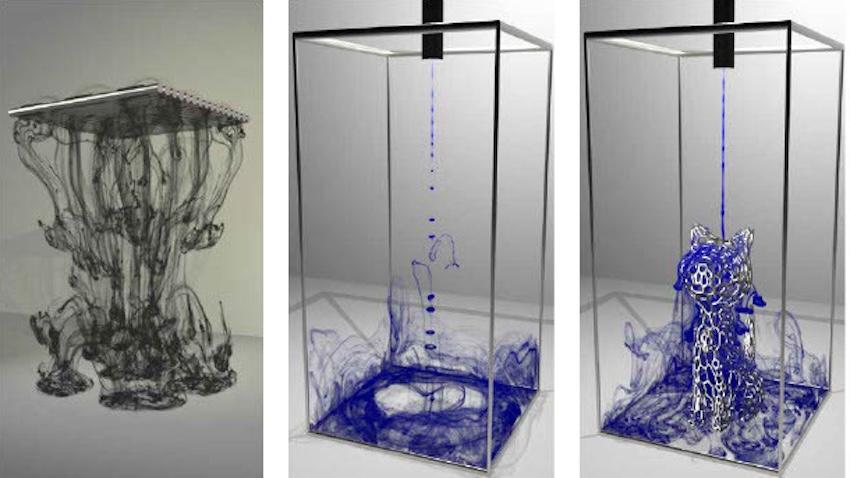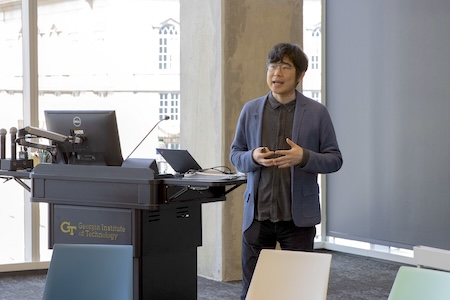
Computer Graphics Team Makes Breakthrough in Simulating Ink Diffusion
Computer graphics researchers at Georgia Tech have introduced a novel method for accurately simulating ink diffusion within water.
Calculating and visualizing a realistic trajectory of ink spreading through water has been a longstanding and enormous challenge for computer graphics and physics researchers.
When a drop of ink hits the water, it typically sinks forward, creating a tail before various ink streams branch off in different directions. The motion of the ink’s molecules upon mixing with water is seemingly random. This is because the motion is determined by the interaction of the water’s viscosity (thickness) and vorticity (how much it rotates at a given point).

“If the water is more viscous, there will be fewer branches. If the water is less viscous, it will have more branches,” said Zhiqi Li, a graduate computer science student.
Li is the lead author of Particle-Laden Fluid on Flow Maps, a best paper winner at the December 2024 ACM SIGGRAPH Asia conference. Assistant Professor Bo Zhu advises Li and is the co-author of six papers accepted to the conference.
Zhu said they must correctly calculate and simulate the interaction between viscosity and vorticity before they can accurately predict the ink trajectory.
“The ink branches generate based on the intricate interaction between the vorticities and the viscosity over time, which we simulated,” Zhu said. “Using a standard method to simulate the physics will cause most of the structures to fade quickly without being able to see any detailed hierarchies.”
Zhu added that researchers had yet to develop a method for this until he and his co-authors proposed a new way to solve the equation. Their breakthrough has unlocked the most accurate simulations of ink diffusion to date.
“Ink diffusion is one of the most visually striking examples of particle-laden flow,” Zhu said.
“We introduce a new viscosity model that solves for the interaction between vorticity and viscosity from a particle flow map perspective. This new simulation lets you map physical quantities from a certain time frame, allowing us to see particle trajectory.”
In computer simulations, flow refers to the digital visualization of a gas or liquid through a system. Users can simulate these liquids and gases through different scenarios and study pressure, velocity, and temperature.
A particle-laden flow depicts solid particles mixing within a continuous fluid phase, such as dust or water sediment. A flow map traces particle motion from the start point to the endpoint.
Duowen Chen, a computer science Ph.D. student also advised by Zhu and co-author of the paper, said previous efforts by researchers to simulate ink diffusion depended on guesswork. They either used limited traditional methods of calculations or artificial designs.
“They add in a noise model or an artificial model to create vortical motions, but our method does not require adding any artificial vortical components,” Chen said. “We have a better viscosity force calculation and a better vortical preservation, and the two give a better ink simulation.”
Zhu also won a best paper award at the 2023 SIGGRAPH Asia conference for his work explaining how neural network maps created through artificial intelligence (AI) could close the gaps of difficult-to-solve equations. In his new paper, he said it was essential to find a way to simulate ink diffusion accurately independent of AI.
“If we don’t have to train a large-scale neural network, then the computation time will be much faster, and we can reduce the computation cost as well as memory cost,” Zhu said. “The particle flow map representation can preserve those particle structures better than the neural network version, and they are a widely used data structure in traditional physics-based simulation.”
As computing revolutionizes research in science and engineering disciplines and drives industry innovation, Georgia Tech leads the way, ranking as a top-tier destination for undergraduate computer science (CS) education. Read more about the college's commitment:… https://t.co/9e5udNwuuD pic.twitter.com/MZ6KU9gpF3
— Georgia Tech Computing (@gtcomputing) September 24, 2024


